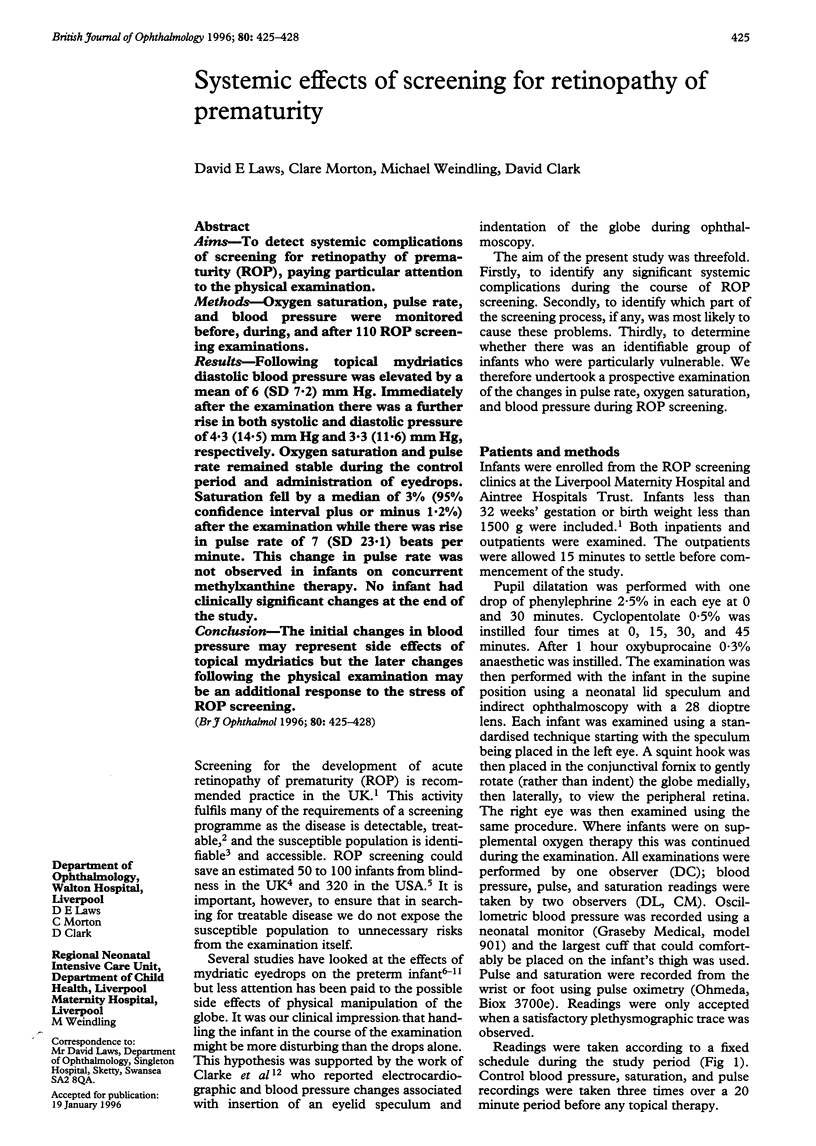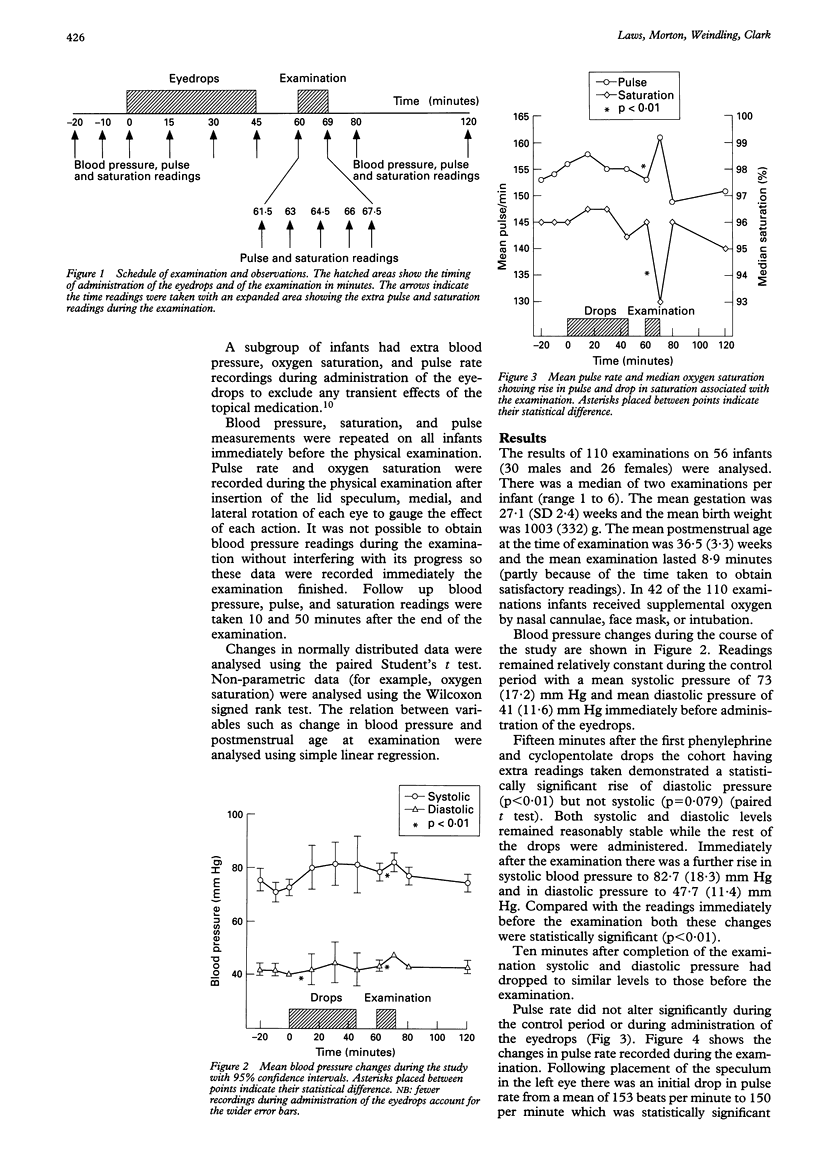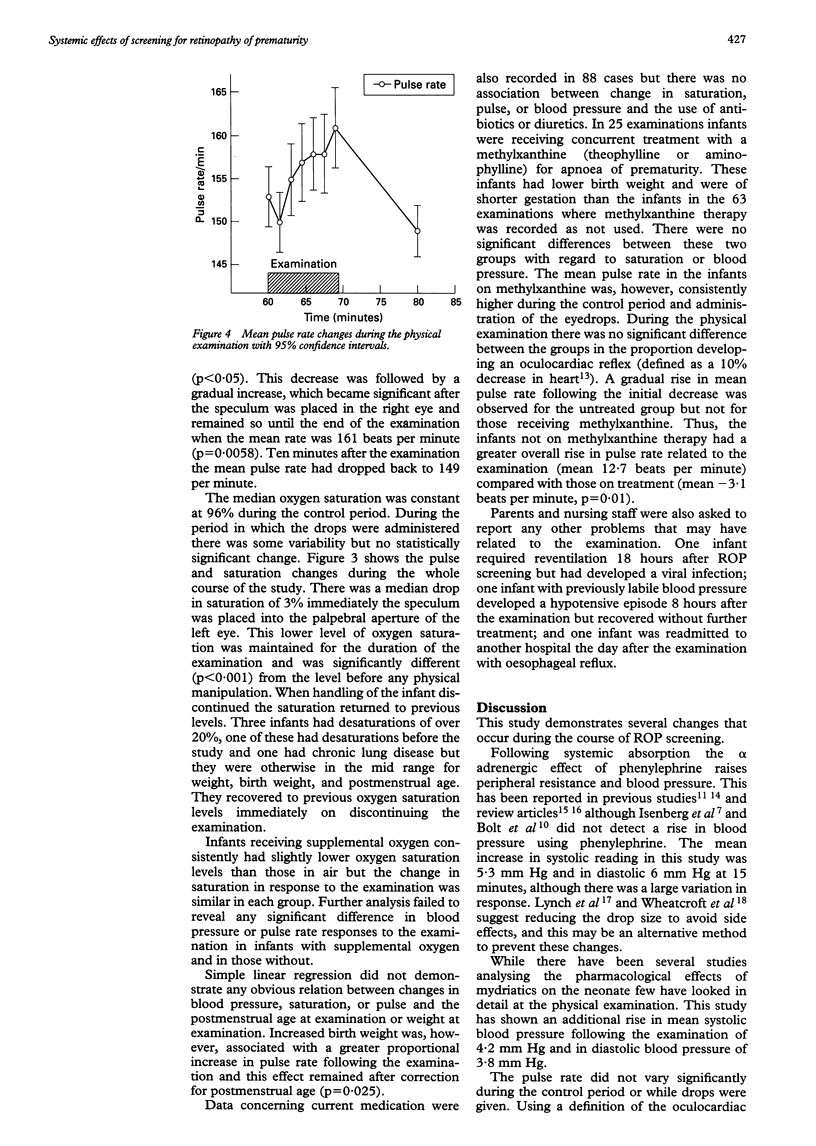Abstract
AIMS: To detect systemic complications of screening for retinopathy of prematurity (ROP), paying particular attention to the physical examination. METHODS: Oxygen saturation, pulse rate, and blood pressure were monitored before, during, and after 110 ROP screening examinations. RESULTS: Following topical mydriatics diastolic blood pressure was elevated by a mean of 6 (SD 7.2) mm Hg. Immediately after the examination there was a further rise in both systolic and diastolic pressure of 4.3 (14.5) mm Hg and 3.3 (11.6) mm Hg, respectively. Oxygen saturation and pulse rate remained stable during the control period and administration of eyedrops. Saturation fell by a median of 3% (95% confidence interval plus or minus 1.2%) after the examination while there was rise in pulse rate of 7 (SD 23.1) beats per minute. This change in pulse rate was not observed in infants on concurrent methylxanthine therapy. No infant had clinically significant changes at the end of the study. CONCLUSION: The initial changes in blood pressure may represent side effects of topical mydriatics but the later changes following the physical examination may be an additional response to the stress of ROP screening.
Full text
PDF



Selected References
These references are in PubMed. This may not be the complete list of references from this article.
- Bates J. H., Burnstine R. A. Consequences of retinopathy of prematurity examinations. Case report. Arch Ophthalmol. 1987 May;105(5):618–619. doi: 10.1001/archopht.1987.01060050036026. [DOI] [PubMed] [Google Scholar]
- Batton D. G., Ivery P., Trese M. Respiratory complications associated with cryotherapy in premature infants. Am J Perinatol. 1992 Jul;9(4):296–298. doi: 10.1055/s-2007-999244. [DOI] [PubMed] [Google Scholar]
- Bauer C. R., Trottier M. C., Stern L. Systemic cyclopentolate (Cyclogyl) toxicity in the newborn infant. J Pediatr. 1973 Mar;82(3):501–505. doi: 10.1016/s0022-3476(73)80134-9. [DOI] [PubMed] [Google Scholar]
- Bolt B., Benz B., Koerner F., Bossi E. A mydriatic eye-drop combination without systemic effects for premature infants: a prospective double-blind study. J Pediatr Ophthalmol Strabismus. 1992 May-Jun;29(3):157–162. doi: 10.3928/0191-3913-19920501-07. [DOI] [PubMed] [Google Scholar]
- Borromeo-McGrail V., Bordiuk J. M., Keitel H. Systemic hypertension following ocular administration of 10 per cent phenylephrine in the neonate. Pediatrics. 1973 Jun;51(6):1032–1036. [PubMed] [Google Scholar]
- Brown G. C., Tasman W. S., Naidoff M., Schaffer D. B., Quinn G., Bhutani V. K. Systemic complications associated with retinal cryoablation for retinopathy of prematurity. Ophthalmology. 1990 Jul;97(7):855–858. doi: 10.1016/s0161-6420(90)32491-0. [DOI] [PubMed] [Google Scholar]
- Clarke W. N., Hodges E., Noel L. P., Roberts D., Coneys M. The oculocardiac reflex during ophthalmoscopy in premature infants. Am J Ophthalmol. 1985 Jun 15;99(6):649–651. doi: 10.1016/s0002-9394(14)76029-5. [DOI] [PubMed] [Google Scholar]
- Dewar K. M. The oculocardiac reflex. Proc R Soc Med. 1976 May;69(5):373–374. doi: 10.1177/003591577606900533. [DOI] [PMC free article] [PubMed] [Google Scholar]
- Fielder A. R., Shaw D. E., Robinson J., Ng Y. K. Natural history of retinopathy of prematurity: a prospective study. Eye (Lond) 1992;6(Pt 3):233–242. doi: 10.1038/eye.1992.46. [DOI] [PubMed] [Google Scholar]
- Isenberg S. J., Abrams C., Hyman P. E. Effects of cyclopentolate eyedrops on gastric secretory function in pre-term infants. Ophthalmology. 1985 May;92(5):698–700. doi: 10.1016/s0161-6420(85)33979-9. [DOI] [PubMed] [Google Scholar]
- Isenberg S., Everett S., Parelhoff E. A comparison of mydriatic eyedrops in low-weight infants. Ophthalmology. 1984 Mar;91(3):278–279. doi: 10.1016/s0161-6420(84)34303-2. [DOI] [PubMed] [Google Scholar]
- Javitt J., Dei Cas R., Chiang Y. P. Cost-effectiveness of screening and cryotherapy for threshold retinopathy of prematurity. Pediatrics. 1993 May;91(5):859–866. [PubMed] [Google Scholar]
- Lahdes K., Huupponen R., Kaila T., Ali-Melkkilä T., Salminen L., Saari M. Systemic absorption of ocular cyclopentolate in children. Ger J Ophthalmol. 1992;1(1):16–18. [PubMed] [Google Scholar]
- Lees B. J., Cabal L. A. Increased blood pressure following pupillary dilation with 2.5% phenylephrine hydrochloride in preterm infants. Pediatrics. 1981 Aug;68(2):231–234. [PubMed] [Google Scholar]
- Lynch M. G., Brown R. H., Goode S. M., Schoenwald R. D., Chien D. S. Reduction of phenylephrine drop size in infants achieves equal dilation with decreased systemic absorption. Arch Ophthalmol. 1987 Oct;105(10):1364–1365. doi: 10.1001/archopht.1987.01060100066027. [DOI] [PubMed] [Google Scholar]
- Palmer E. A. How safe are ocular drugs in pediatrics? Ophthalmology. 1986 Aug;93(8):1038–1040. doi: 10.1016/s0161-6420(86)33624-8. [DOI] [PubMed] [Google Scholar]
- Schulenburg W. E., Acheson J. F. Cryosurgery for acute retinopathy of prematurity: factors associated with treatment success and failure. Eye (Lond) 1992;6(Pt 2):215–220. doi: 10.1038/eye.1992.42. [DOI] [PubMed] [Google Scholar]
- Wheatcroft S., Sharma A., McAllister J. Reduction in mydriatic drop size in premature infants. Br J Ophthalmol. 1993 Jun;77(6):364–365. doi: 10.1136/bjo.77.6.364. [DOI] [PMC free article] [PubMed] [Google Scholar]


